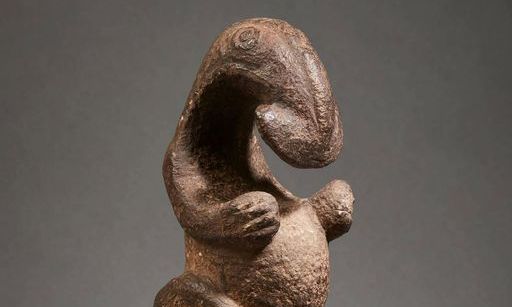The Laiagam Stone Image: courtesy of Chris Boylan Oceanic Art
A ritual figurative stone sculpture that emerged out of the Papua New Guinea Highlands in the 1960s will make its world debut when an Australian Oceanic art dealer features it in his stall at Parcours des Mondes, the tribal art fair in Paris (10-15 September).
The Laiagam Stone, named for its location of origin and measuring around 20cm high, will be offered as an object of conversation and fascination by Chris Boylan of Chris Boylan Oceanic Art in Sydney.
Boylan says he has no real idea what the sculpture could be worth but that the very similar Ambum Stone in the collection of the National Gallery of Australia is valued at A$6m (US$4m).
The Ambum Stone was also collected from the Highlands and acquired by the NGA in 1977 from a London dealer. It was unfortunately broken while on overseas loan. In the one good thing to come of the accident, the stone split along a fault line, exposing a fragment of ancient vegetation that had penetrated along the crack.
The plant material was carbon-dated to 3,500 years old, making this the minimum age of the object. The Ambum Stone was subsequently restored and stabilised, and returned to public display.
The Ambum Stone in the collection of the National Gallery of Australia Image: © NGA
Boylan believes the Laiagam Stone is also at least 3,500 years old, because of the marked similarities between the two pieces, which depict a squatting figure with human and animal characteristics including a protruding belly and long proboscis.
The Laiagam Stone was collected by Ron Ingle, an Australian engineer who worked on roads and other projects in the Highlands in the 1960s.
When Ingle returned home to the Sunshine Coast in Queensland, he sold some of the stone objects he’d collected through Chris Boylan. Boylan’s clients have included the National Gallery of Australia and the Musée du Quai Branly in Paris, along with private clients such as the naturalist David Attenborough.
Boylan is not sure whether Ingle, who died around ten years ago, secured any kind of export licence for the Laiagam Stone. But he believes Ingle could well have saved the stone from ending up as aggregate for mending roads. This was a fate suffered by many stone objects when Christian missionaries held sway in Papua New Guinea and many tribal people turned away from their own cultures.
Although nothing is known of the ritual role played by the Laiagam Stone, Boylan says it could have been covered in magic oils or pigs’ blood during ceremonies and been buried in between being brought out for ritual purposes.
While up to 20 or 30 similar ritual stones have been recovered from the Highlands, Boylan says only three can be described as intact, beautiful works of art.
One is the Ambum Stone, another is in a private collection in the US, and the third is the Laiagam Stone.

